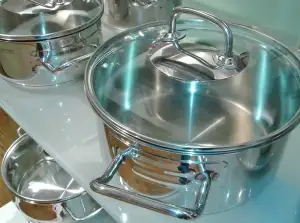Revive Your Rusty Cast Iron: A Step-by-Step Guide to Cleaning and Restoring

Cast iron cookware has been cherished for generations due to its durability and excellent heat retention properties. However, over time, cast iron can develop rust, which not only affects its appearance but also its performance. Rusty cast iron can lead to uneven heating and a metallic taste in your food. Therefore, it is crucial to clean and restore your rusty cast iron to maintain its beauty and functionality. In this step-by-step guide, we will walk you through the process of reviving your rusty cast iron so that you can continue to enjoy cooking with it for years to come.
Gather the necessary supplies for cleaning
Before you embark on the journey of cleaning and restoring your rusty cast iron, it's important to gather all the necessary supplies. Here's a list of items you'll need:
1. Stiff brush: Look for a brush with firm bristles that can effectively scrub away rust and grime from the surface of your cast iron.
2. White vinegar: Vinegar is a powerful natural cleaner that can help dissolve rust. Make sure to get enough vinegar to soak your cast iron in later.
3. Water: You'll need water for rinsing and soaking purposes throughout the cleaning process.
4. Steel wool or scrub pad: This will be used to scrub away any remaining rust after soaking.
5. Paper towels or clean cloth: These will come in handy for drying your cast iron after cleaning.
6. Cooking oil or shortening: Once your cast iron is clean and dry, you'll need oil or shortening for seasoning it and preventing future rusting.
By gathering these supplies beforehand, you'll be well-prepared to tackle the task of reviving your rusty cast iron and bringing it back to its former glory.
Step 1: Scrubbing the rust with a stiff brush
To begin the process of reviving your rusty cast iron, you'll need a stiff brush. This will help loosen and remove the surface rust. Start by running the brush under warm water to moisten the bristles. Then, firmly scrub the rusty areas in a circular motion. Apply some pressure, but be careful not to damage the cast iron surface. Continue scrubbing until you see the rust starting to come off. Remember to focus on all sides of the cast iron, including the handle and any intricate designs or patterns. Once you've thoroughly scrubbed away as much rust as possible, it's time to move on to step 2: applying a vinegar solution.
Step 2: Applying a vinegar solution to remove stubborn rust
Once you have scrubbed away as much loose rust as possible, it's time to tackle the stubborn spots. To do this, create a vinegar solution by mixing equal parts white vinegar and water in a bowl or container.
Using a cloth or sponge, dip it into the vinegar solution and apply it directly to the rusty areas of your cast iron. Make sure to cover all the affected spots thoroughly.
The acidity of the vinegar will help break down the rust and make it easier to remove. Leave the vinegar solution on for about 15-20 minutes, allowing it time to work its magic.
During this time, you may notice some fizzing or bubbling as the vinegar reacts with the rust. This is perfectly normal and indicates that the solution is actively removing the rust.
After the allotted time has passed, grab your stiff brush again and give those rusty areas another good scrubbing. You should see that much of the remaining rust comes off easily now.
Continue scrubbing until you are satisfied with the results. If there are still some stubborn spots, don't worry - we'll address those in the next step.
Remember to rinse off any residual vinegar solution thoroughly before moving on to Step 3. This will ensure that no acidic residue remains on your cast iron surface.
Step 3: Soaking the cast iron in a vinegar bath
After scrubbing off as much rust as possible, it's time to give your cast iron a vinegar bath. Fill a basin or sink with equal parts water and white vinegar. Make sure the solution is deep enough to fully submerge your rusty cast iron.
Place the cast iron in the vinegar bath and let it soak for at least one hour. The acidic properties of the vinegar will help break down any remaining rust and loosen it from the surface of the pan.
During this soaking period, you may notice bubbles forming on the surface of the cast iron. This is a good sign that the vinegar is working its magic and reacting with the rust.
If you have particularly stubborn rust spots, you can also use a cloth soaked in vinegar to gently scrub those areas while they are submerged. Be careful not to scratch or damage the surface of the cast iron.
Once the soaking time is up, remove the cast iron from the vinegar bath and rinse it thoroughly with warm water. Use a clean cloth or paper towels to dry it completely before moving on to the next step.
By soaking your cast iron in a vinegar bath, you're ensuring that all traces of rust are being removed, leaving behind a clean and restored surface ready for seasoning.
Step 4: Scrubbing away remaining rust with steel wool
After soaking the cast iron in the vinegar bath, it's time to tackle any remaining rust. Take a piece of steel wool and gently scrub the surface of the cast iron. The abrasive nature of the steel wool will help remove any stubborn rust spots that may still be present.
Be sure to apply enough pressure while scrubbing, but avoid using excessive force as it may damage the surface of your cast iron. Work in small circular motions, focusing on areas where rust is more prominent.
Continue scrubbing until all traces of rust have been removed and the surface feels smooth to the touch. You may need to rinse and reapply vinegar solution as you go along to aid in the removal process.
Remember to be patient during this step, as removing rust can take some time depending on the severity of the rust buildup. Take breaks if needed and don't rush through this process.
Once you're satisfied with the results, rinse off any residue from the steel wool and move on to the final step - drying and seasoning your cast iron.
Step 5: Drying and seasoning the cast iron
After successfully removing all the rust from your cast iron, it's important to thoroughly dry it to prevent any new rust from forming. Use a clean towel or paper towels to wipe away any moisture.
Next, place the cast iron on a stovetop burner set to low heat. Allow the heat to gently dry the cast iron for about 10 minutes. This will ensure that all traces of moisture are completely evaporated.
Once the cast iron is dry, it's time to season it. Seasoning helps to create a protective layer on the surface of the cast iron, preventing it from rusting and enhancing its non-stick properties.
To season your cast iron, apply a thin layer of vegetable oil or melted shortening all over its surface, including the handle and exterior. Use a paper towel or cloth to spread the oil evenly.
Preheat your oven to 350°F (175°C). Place the oiled cast iron upside down on the center rack of your oven with a baking sheet or aluminum foil underneath to catch any drips.
Bake for one hour, then turn off the oven and allow the cast iron to cool completely inside before removing it. The heat will help bond the oil to the surface, creating a durable seasoning layer.
Remember, regular maintenance is key in preserving your newly restored cast iron. After each use, clean it with hot water and a gentle brush or sponge. Avoid using soap as it can strip away the seasoning. Dry thoroughly and lightly coat with oil before storing in a dry place.
By following these steps, you can revive your rusty cast iron and enjoy its beauty and functionality for years to come!
Conclusion: Maintaining the beauty and functionality of your cast iron is essential to prolong its lifespan and ensure optimal cooking performance. After cleaning and restoring your rusty cast iron, it's important to continue caring for it properly. Remember to always dry your cast iron thoroughly after each use to prevent rust from forming again. Additionally, regularly seasoning your cast iron with a thin layer of oil will help maintain its non-stick surface and prevent it from rusting. With proper care, your cast iron will continue to be a reliable kitchen companion for years to come, providing you with delicious meals and lasting memories.
Published: 11. 12. 2023
Category: Home



